Kapa Haka
Te Puna
Atua: Tānerore.

Whakapapa
The whakapapa of Tānerore (PDF, 38 KB)
Pūrākau
Hine Takurua rāua ko Hine Raumati
Retold by Hana Pōmare, translated by Hēni Jacob.
Published in the journal Hine Raumati 1, pages 4–7, (2015, item number 711252).
The sun god Tamanuiterā and one of his wives, Hine Raumati, had a son named Tānerore. The quivering appearance of the air on hot summer days is a sign of Tānerore dancing for his mother, and this light, rapid movement is the foundation of all haka, with the trembling hands in particular representing the dance of Tānerore.
Waiata
Te Whānau a Tamanuiterā
Lyrics by Hana Pōmare, music by Iain Gordon and Aaron Tokona.
Order a copy of the resource Te Ao Hurihuri, (2001, item number 10343) Included in the kit is a CD of waiata based on Māori cosmology – Te Whānau a Tamanuiterā is track 7.
Te Whānau a Tamanuiterā (SoundCloud)
Te Whānau a Tamanuiterā
By Wai, from the album Ora.
https://www.youtube.com/watch?v=Dgkom690Mpw
Karakia
Te Haka a Tānerore
Composed by Nuki Tākao.
"Nā Urutengangana
Ko Tamanuiterā
Nā Tamanuiterā
Ko Tānerore
E tū i te tū a Tānerore
E haka i te haka a Tānerore
Kia ihi
Kia wehi
Kia wana e!"
Whakataukī
E tū i te tū a Tānerore,
E haka i te haka a Tānerore.
He Atua! He Kōrero!
The whakapapa of Tānerore (PDF, 38 KB)
Ako ā-Kākā
Rote learn the whakapapa of Tānerore.
Ka moe a Ranginui i a Papatūānuku
Ka puta ko Urutengangana
Ka moe a Urutengangana i a Hine Te Āhuru
Ka puta ko Tamanuiterā
Ka moe a Tamanuiterā i a Hine Raumati
Ka puta ko Tānerore.
Atua Masks
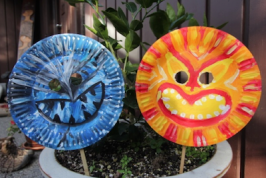 What you need
What you need

- Paper plate with holes cut for eyes
- Sticks for attaching to the plates
- Masking tape
- Paints, glitter, feathers, wool, foil, leaves (for decorating)
- Paintbrushes
- Glue
What you do
- Organise the students into seven groups – one for each atua in the whakapapa.
- Students paint and decorate a paper plate to reflect their atua.
- Tape a stick to the back.
-
Practise the whakapapa with each student reciting the part that relates to them, e.g:
- Child 1: ‘Ka moe a Ranginui’
- Child 2: ‘i a Papatūānuku’. -
Perform as a series of mini plays.
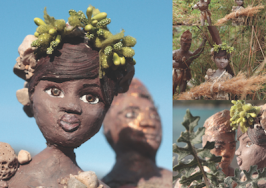
Hine Takurua rāua ko Hine Raumati
What you need
- Hine Takurua rāua ko Hine Raumati published in the journal Hine Raumati 1, pages 4–7, (2015, item number 711252)
What you do
- Tell the story of Hine Takurua rāua ko Hine Raumati. Ask students to listen very carefully so they can play a game afterwards that relates to the story.
Play ‘Roll and Retell’
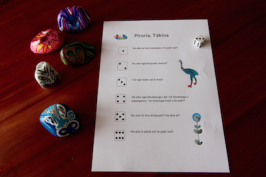
You can play this after shared, guided reading, independent or partner reading.
What you need
- Dice
- Copies of the Pīroria Tākina PDF copymaster.
What you do
- Work as class, in small groups or in pairs. Students take turns at rolling the dice and answering questions.
Te Haka a Tānerore
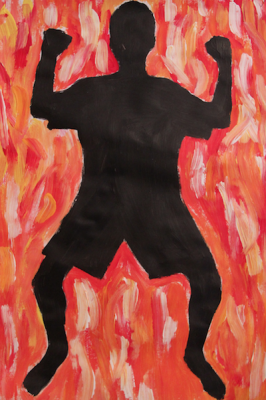 Ako ā-Kākā
Ako ā-Kākā

Learn the karakia by rote and have the students recite it before any kapa haka activities, practises and performances.
Tānerore
What you need
- A3 white paper
- Yellow/red/white paints
- Paintbrushes
What you do
- Talk with students about how Tānerore is related to Tamanuiterā and Hine Raumati; his role as the god of haka; and how you know when he is present (te kārohirohi).
- Take photos of students in front of a light background in a haka stance.
- Print onto A3 paper, (greyscale).
- Do an art activity where they paint around the silhouette in yellows, oranges and reds to represent the shimmering of Tānerore in summer, dancing for his mother Hine Raumati.
- Have an ‘Art Appreciation’ conversation once all the pictures are completed and the paint has dried, asking key questions:
-
- What did you enjoy most about this activity?
- What do you like best about your picture?
-
What do you know now that you didn’t know before?
Haka
- Students stand in a circle, with one student in the middle. That student does a haka action e.g. stamping the foot, slapping thighs, raising hands – the rest follow. Group repeats action until another student runs into the middle, tags the person and starts a new action.
- Use the words of the karakia for a haka. Organise students into 4 groups. Give each group a set of lines from the karakia.
- Each group comes up with appropriate actions for the four parts of the haka:
-
Nā Urutengangana
Ko Tamanuiterā -
Nā Tamanuiterā
Ko Tānerore -
E tū i te tū a Tānerore
E haka i te haka a Tānerore -
Kia ihi
Kia wehi
Kia wana e!
- Groups practise their section with words and actions. All groups then come together and perform their respective parts of the new haka in order. Each group teaches the wider group their section.
- Discuss whether the parts all work together, or whether they need to adjust parts to work better.
Note
- You could get older students to help facilitate each group.
- You could involve both boys and girls, or have boys and girls work separately and see what they come up with.
E tū i te tū a Tānerore
E tū i te tū a Tānerore, E haka i te haka a Tānerore.
- Tell the story of Tānerore again to explain the meaning of the whakataukī.
- Teach the whakataukī as a pao for the girls and as a mini-haka for the boys.
- Have students practise using the pao and haka iti during class kapa haka sessions to build their confidence for using in a more public forum.
- Explain that this whakataukī is perfect for acknowledging individuals and groups who have excelled (in their eyes) at kapa haka, e.g. at a kura performance for the whānau.
Possible Assessment Opportunities
Students can:
- Create and perform a short a play based on the whakapapa of Tānerore.
- Recall parts of the pūrākau using the ‘Roll and Retell’ activity.
- Participate in an art appreciation activity. (Record the conversations.)
- Work cooperatively to compose mini haka and collaborate as a whole group to put the haka ‘together’.
- Compose beats and sounds for waiata and record.
- Perform pao (girls) and haka (boys) at appropriate occasions.
Kapa Haka
Tītī Torea
-
Start by introducing the locatives: taha matau, taha mauī, mua, runga, and raro.
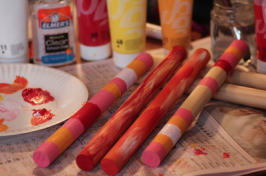
- Teach and play games that consolidate understanding and usage of these words e.g:
-
- Hei Tama, Tū Tama
- Simon Says
- Blindfolded Obstacle Course challenge.
Make Tītī Torea
What you need
- 2.5mm diameter dowelling, cut into 30 cm lengths (2 per student) – undercoat the dowelling rods before the lesson
- Scissors
- Red and yellow paint
- Paintbrushes
- Plastic plate to mix colours
- Black permanent marker
What you do
- Give the students a restricted palette of red and yellow to decorate their tītī torea (i.e. colours of Tamanuiterā).
- Get them to explore mixing colours to produce shades of orange.
- Let them paint their sticks and leave them to dry.
- Add patterns with a permanent marker (optional).
- Teach tītī torea to the class using the focus locatives in your instructions.
Story Stones
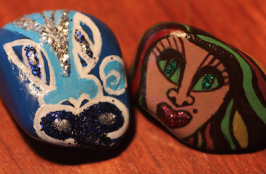
Story stones are smooth, flat stones with pictures on them. You can make story stones by painting a picture, using stickers, drawing with a permanent marker, or using magazine cutouts.
Story stones can be used in many ways …
- Story telling
A student chooses a stone from a basket and uses the picture on it as a story starter. The story could be added to by the student choosing another stone. This could also be done in groups, where students take turns at adding to a story e.g. 1 stone = 1 sentence.
Note
Students could begin by selecting more than one stone to build a story.
Prompt students with questions to help them get started or carry on further with their story.
- Creative play
-
- With building blocks
- Doll houses
- Animals in a zoo, on a farm; birds in a forest
- Food in a kitchen, on a table
- Sorting and grouping
Organise into sets e.g. atua, people, food, animals, vehicles.
Making Story Stones
What you need
- Flat stones
- Paint and paintbrushes
- Magazines or fabric
- Permanent marker
- Scissors
- Mod Podge or glue
What to do
- Make a series of story stones based on the atua in this unit: Ranginui, Papatūānuku, Urutengangana, Hineteāhuru, Hinetūrama, Tamanuiterā, Hine Raumati, Hine Takurua and Tānerore. Add in other stones on the kapa haka theme.
- Make different sets using the different decorating ideas.
- Use Mod Podge, an excellent glue and sealer, if you are using fabric or magazine cut-outs. Use Mod Podge to seal painted stones.
Possible Assessment Opportunities
Students can:
- Use story stones to tell their own story about Tamanuiterā or another atua.
- Compose a waiata based on the whakapapa of Tānerore.
- Use tītī torea and follow instructions focusing on locatives.
